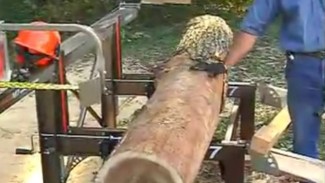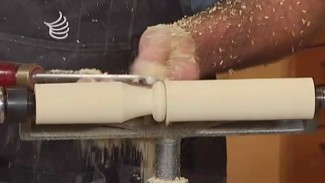If you’re looking for a fast and easy way to build rock solid drawers, we’ve got exactly what you need on how to build drawers. All it takes is a router table, a slot cutting router bit and a little practice, and you’ll be building perfect drawers in no time.
Drawers Get Abused
Drawers take a lot of abuse. How many open/closed cycles does a drawer see in its lifetime? Lots and lots. Add heavy items to the drawer, like tools in a workshop drawer or utensils in a kitchen drawer, and the demands on a drawer become significant. For the drawers to hold up, you need to know how to make cabinet drawers. This doesn’t have to become a time consuming woodworking project, provided you know a few tricks of the trade.
Router Table Drawers
There are two keys to Instant Drawers; the router table and a slot cutting router bit. Once the bit is correctly set you’ll be amazed at how quickly you can make perfect drawers. This technique will deepen your arsenal of skills on how to use a router table.
More on How to Build Drawers
WoodWorkers Guild of America provides lots of great video instruction on how to build drawers. You can learn how to set up a dovetail jig and how to make sliding dovetails, both great techniques for making drawers that will stand up to the test of time. We’ve also got tips on drawer slides and attaching drawer fronts.






Several things here. It looks like a rabbet bit is being used. It is wide and is totally unnecessary. It prevents closure of the fence, which will make it more likely to pull the work piece into the gap between the fence. Using a simple straight bit will prevent that as the fence can be closed for some cuts and open only for the width of the bit for others. Bit height should be no more than 1/2 the thickness of the work piece. A digital height measurement device can help. There are other bit options for better drawer box joints including dovetail, miter and drawer lock bits that yield stronger or more cosmetically acceptable joints but they’re more complicated to set up and more expensive. It is unlikely that the drawer bottom thickness will be the same size as the tongue and groove cuts in this video. Actual plywood thicknesses are typically less than stated by 1/32 to a full 1/16″. The bottom grooves need to be adjusted accordingly. It is bad form to cut those grooves through the sides of fronts and backs. In this video, they would need to be filled in, which is extra work and time with only so-so results. In general, routing a piece vertically on the table should be avoided, if possible. Control of the work piece in that situation is reduced with it possibly twisting into the fence gap or the leading edge dropping into the gap between the bit and the magnetic ring. If you must do vertical routing, consider using a sacrificial fence. A one-piece, sacrificial fence avoids the difficult and common issues when each fence side is not perfectly aligned and exactly perpendicular to the table bottom along it’s full height. Lastly, keep a written log of your common cuts. Measure the distanced from the fence to the edge of the miter slot. Use the same ruler for these measurements and measure from the lateral sides of the table, not just directly in front of the bit. By using a magnifying glass, accuracy should be to about 1/4 mm for nice, predictable results. Be careful when cutting deep slots with a 1/4″ shank diameter bit. Cut in up to 1/8″ increments to help avoid pulling the bit out of its collet. Make sure the bit is very, very tight when using 1/4″ shanks or the work piece will be damaged when the bit move upward. If routing becomes more difficult, suspect that this is happening and immediately stop and investigate. This issue is much less when using 1/2″ shanks, which should be used whenever possible. The smaller the bit cutting diameter, the more likely the bit will break off, so it makes sense to have a duplicate bit. This video has been speeded up, but you need to route at the speed your router and bit can handle the cut. Don’t force it. When routing long pieces, using a feather board clamped to the fence can help ensure that the work piece will stay flat against the top and that can help compensate for mild wood warpage. There are instructions on the Web on how to make feather boards from scrap wood.
Give me a break. Leave no stone unturned nor any nit unpicked.
What kind of router bit was used?
I’m just starting on wood working and slowly building up tools and equipment. Your videos are great and very instructive. What size slot bit is being used in this video? I have found 2 & 3 wings and various sizes.
Never mind! Some how I missed at the beginning of the video where it displayed the slot bit size.
I have tried this several times and I can’t get it to fit. I am using a 1/4″ 3 wing slot cutter and tried moving the fence, the bit, nothing fits. I’m using 1/2″ cedar planks for test pieces and need help figuring out what I am doing wrong! Please help. The video looks so easy….
My best guess is that the 1/2″ planks that you are using are actually slightly thinner than this. If you use anything other than exactly 1/2″ stock, this system won’t work. If your stock is slightly off of 1/2″, don’t sweat it. Just take your time and measure carefully and make any adjustments necessary to achieve the perfect fit. You might find it easier to make the drawer parts on a table saw, which is how I normally do it. You can see a similar drawer being made on a table saw here: https://www.wwgoa.com/article/modern-media-cabinet-part-6-drawers-and-hardware/
Paul
Woodworkers Guild of America
there are no responces to read even though it says there are 23
Hello. This issue has now been fixed. I am sorry for any inconvenience.
Thanks
Jean-Woodworkers Guild of America Video Membership
What bit/ bits are used for this
Hi Alex. Here you go:
https://amzn.to/2PwEUa5
Thanks
Paul-WWGOA
Great short and to the point video – the kind I like. But the best part for me was the music. What song was that?
I logged in to watch your post haste video on building drawers with a slot cutting bit on a router. However, the video does not load. I use Firefox browser. I did attempt it using Internet Explorer (first time in a year or so I have used IE), and it worked. Is there a setting that I need to use with Firefox to view your videos?
Hi Paul. I am sorry you are having trouble viewing the video. I have emailed you a troubleshooting email that should help you with this. If you are still having trouble viewing the video, please contact our customer service at 1-855-253-0822 and they can assist you.
Thanks
Jean-WWGOA Video Membership
Sorry ezgoing, but the first thing this old guy liked WAS the music, a real toe tapper. The video was on the spot. I am starting a load of drawers today and just might switch to this style of construction just for the fun of it. Great job George and team.
Is a slot cutter the same thing as a wing slot cutter? I’m trying to make the instant drawer and it’s too loose of a fit. I have the wing slot cutter
Hi Becky, these two items serve the same purpose and as long as you have the right size you can do this with a wing slot cutter. Paul
Dumb question. I restarted the video several times, but all I hear is music. Did I miss something? Is there any audio (not music) to go with this vid?
Hi, Randy! This video does not have any audio to accompany it.
Thanks! Now I have to wait for my thumb to heal after the spinning router bit gouged my thumb.
Awesome Geo. It doesn’t get any easier than this. Gr8 video. Really like the jams/harmonica/guitar/etc.
Awesome Geo. It doesn’t get any easier than this. Gr8 video
Very good tip, but have to say I’m not a fan of the music. I understand your trying to keep the younger generations happy too, but at least keep the volume level down to around the same level of the other video clips please… GREAT idea on a quick and simple drawer though… Thanks!
Love the music, Beethoven sonata??? Naaa!
I think I answered my own question. The groves are for installing a bottom to the box. Knew it was something simple!!! 🙂
The video looks like the box is put together by the short ends, so what is the reason for the grove on the long sides of the four sides? I know I,m missing something in the video but I don’t know what. It just does not like this grove is being used?
Great question. The long groove is for the drawer bottom, which would be made using 1/4″ plywood in this case.
The video says to use 1/2″ stock. Why can’t a guy use 3/4″ such as a 1×4 or such instead? Raise the bit to 3/8″ instead of 1/4″?
1/2″ stock is common for drawer sides but you can use the approach presented here for drawers of other thicknesses by making the adjustments that you have described.
Thank’s! You guys rock!
When I tried this, setup was a pain in the posterior, but what killed it for me was all the tear out I was getting on the side pieces (front and back were okay). I’m using 1/2″ baltic birch plywood.
Any suggestions?
Hi, Ron!
Sorry to hear that you are having this problem. Sounds like you were getting tearout when cross-cutting the face veneer on the BB plywood. BB can be chippy stuff. Here are a couple suggestions that you might try:
– Most likely your problem is caused by open spacing on your fence which allows the router bit to freely tear away at the wood surface without any reinforcement holding the wood in place. I suggest trying this approach to fixing the problem first first: https://www.wwgoa.com/video/zero-clearance-router-table-fence-000361/. If that doesn’t address the problem, then perhaps look into these other options.- score your cut lines with a utility blade prior to routing, using a straight edge to follow the line. A couple strokes across the veneer to slice through the top layer should give you a clean cut.- dampen the wood prior to routing. Sometimes this can help minimize tearout.- A dull router bit can cause tearout, so be sure that the bit you are using is sharp.- This technique also works well on a table saw using a dado blade, so if you cannot get it producing good results on your router table, you might want to try it on a table saw.
I think glossing over the setup and not actually talking while doing this would be helpful. From watching this video, there was no way to judge your setup height or depth